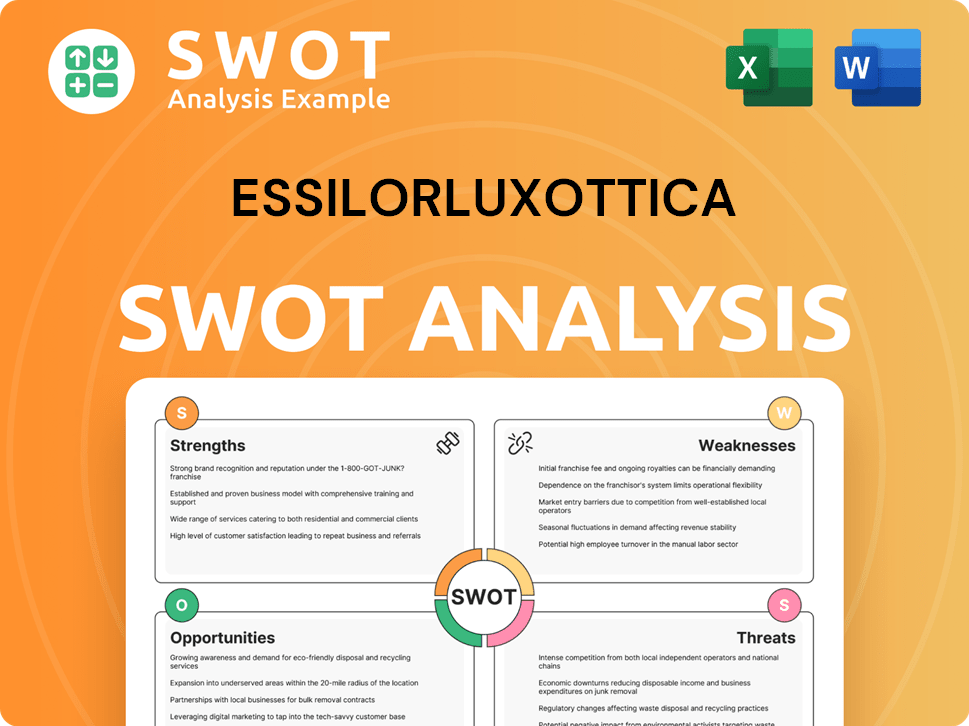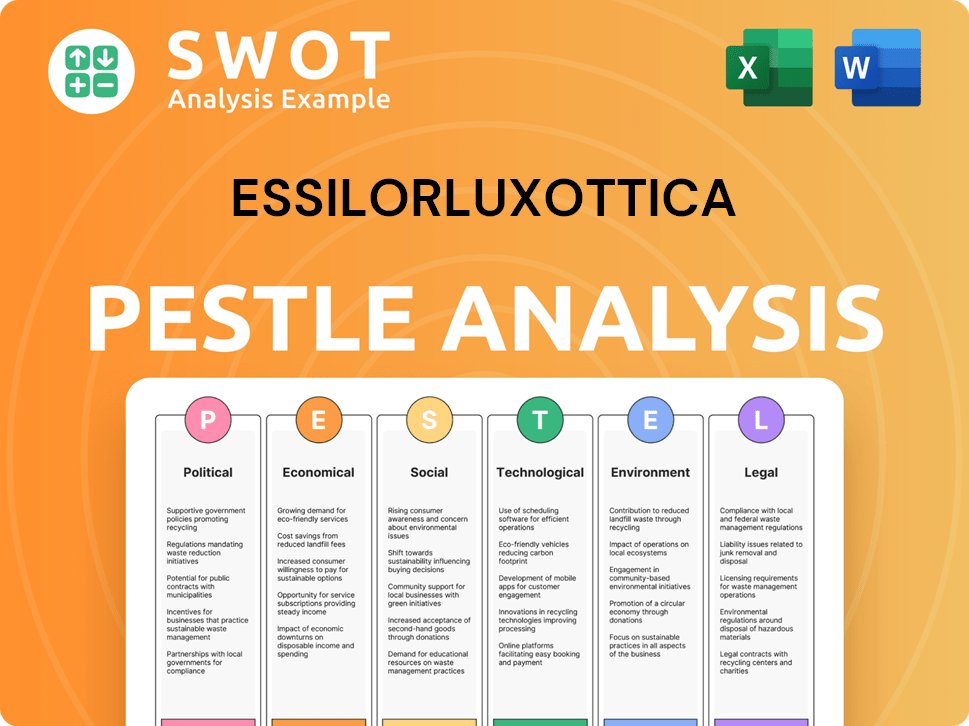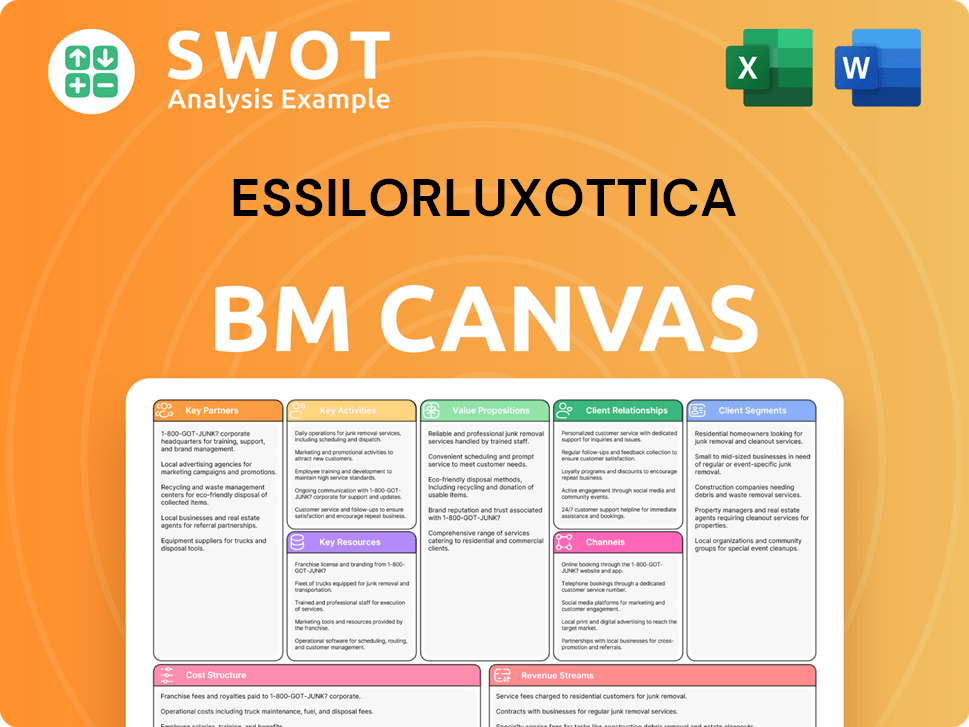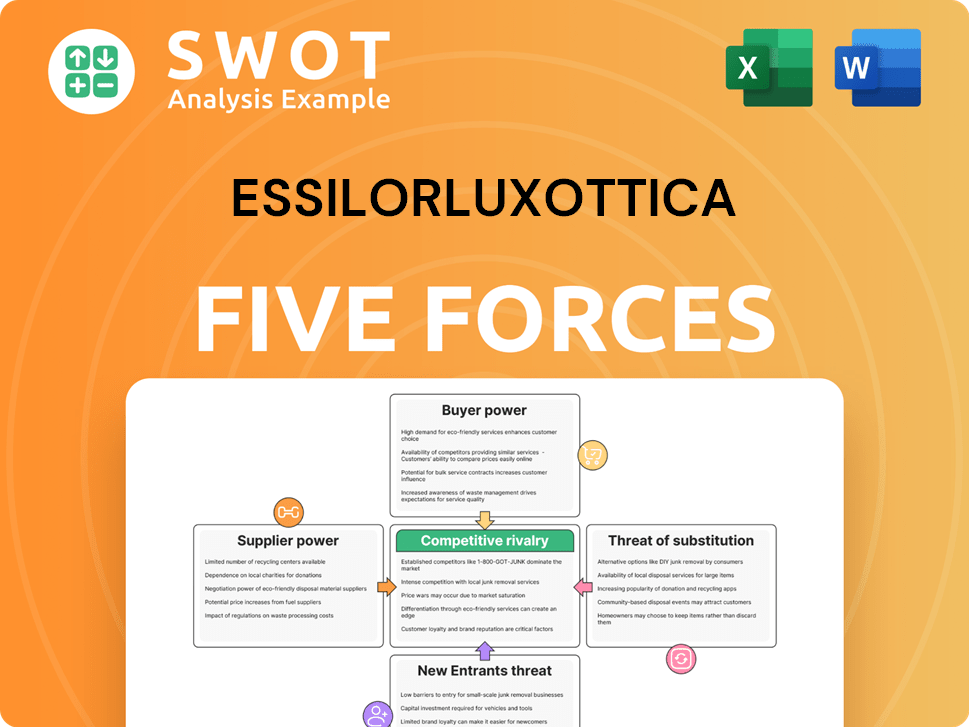EssilorLuxottica Bundle
Who Truly Owns EssilorLuxottica?
Ever wondered who steers the vision of a global eyewear giant? The story of EssilorLuxottica, formed from the merger of Essilor and Luxottica, is a fascinating tale of strategic alliances and market dominance. Understanding the EssilorLuxottica SWOT Analysis reveals the power dynamics behind its iconic brands like Ray-Ban and Oakley. Unraveling the EssilorLuxottica ownership structure offers crucial insights into its future.

This deep dive into EssilorLuxottica's corporate structure will explore the key players and their influence. We'll examine the evolution of its ownership, from the founders of Essilor and Luxottica to the current major shareholders. Knowing "Who owns EssilorLuxottica" is vital for anyone seeking to understand this leading eyewear company and its position in the market. We will explore topics such as: EssilorLuxottica shareholders, EssilorLuxottica stock ownership, and the EssilorLuxottica parent company.
Who Founded EssilorLuxottica?
The story of EssilorLuxottica begins with the separate journeys of Essilor and Luxottica, two major players in the eyewear industry. Understanding their origins is key to grasping the current EssilorLuxottica ownership structure. Essilor's roots are in a cooperative of eyewear makers in Paris, while Luxottica was founded by Leonardo Del Vecchio in Italy.
Essilor's evolution involved mergers and expansions, transforming from a cooperative into a global leader in ophthalmic lenses. Luxottica, on the other hand, focused on vertical integration, building a brand that would transform eyewear into a fashion accessory. The contrasting yet complementary strategies of these two companies set the stage for their eventual merger.
The early ownership of these companies reflects their distinct paths. While specific details of the initial equity in Essilor's cooperative are less documented, Leonardo Del Vecchio's control over Luxottica through his holding company, Delfin, was critical. This control would be pivotal in the future of the combined entity.
Founded in 1849 as a cooperative in Paris, initially known as the Association Fraternelle des Ouvriers Lunetiers. It later evolved into Société des Lunetiers (SL) and then Essel.
Established in 1961 in Agordo, Italy, by Leonardo Del Vecchio. It started as a workshop producing for the optical industry.
Luxottica quickly pursued vertical integration, acquiring distribution companies and signing licensing agreements. This strategy was key to its growth.
Essilor expanded internationally, opening offices and exporting to various regions. A merger with SILOR in 1972 created the Essilor Group.
Leonardo Del Vecchio maintained significant control over Luxottica through his holding company, Delfin. Essilor's early structure was based on a cooperative model.
Luxottica listed American depositary receipts on the New York Stock Exchange in 1990, expanding its reach in the financial markets.
The early histories of Essilor and Luxottica, including their founding and initial ownership structures, are critical to understanding the current EssilorLuxottica shareholders and who owns EssilorLuxottica. The Brief History of EssilorLuxottica offers a deeper dive into the company's milestones. Early decisions, such as Del Vecchio's control of Luxottica, shaped the future of the company. The evolution of Essilor from a cooperative to a global leader, and Luxottica's focus on vertical integration, set the stage for their eventual merger. These factors are essential for anyone examining the EssilorLuxottica ownership details and its corporate structure.
- Essilor's origins were in a cooperative, while Luxottica was founded by an entrepreneur.
- Luxottica's vertical integration strategy was key to its early success.
- Leonardo Del Vecchio's control of Luxottica was a significant factor.
- Understanding these early dynamics is essential for analyzing the current ownership.
EssilorLuxottica SWOT Analysis
- Complete SWOT Breakdown
- Fully Customizable
- Editable in Excel & Word
- Professional Formatting
- Investor-Ready Format

How Has EssilorLuxottica’s Ownership Changed Over Time?
The most significant shift in the EssilorLuxottica ownership structure occurred with the merger of Essilor and Luxottica. Announced in January 2017 and finalized on October 1, 2018, this union created a global leader in the eyewear industry. At the time of the merger, the combined revenues surpassed €16 billion, with a market capitalization of €57 billion.
Following the merger, Essilor became the parent company, and was renamed EssilorLuxottica. Delfin S.à r.l., the holding company of Leonardo Del Vecchio, which previously held 62.42% of Luxottica, contributed its stake and became the primary shareholder of the newly formed company. This strategic move reshaped the corporate structure and set the stage for the company's future growth and market dominance. This merger was a critical point in the EssilorLuxottica ownership history.
| Shareholder | Shareholding as of December 31, 2024 | Approximate Value (USD) |
|---|---|---|
| Delfin S.à r.l. | 32.3% (147,589,999 shares) | Approximately $42.8 billion |
| General Public | 37.2% | N/A |
| Institutional Investors | 29% | N/A |
As of December 31, 2024, Delfin S.à r.l. remains the largest single EssilorLuxottica shareholder, with 32.3% of the shares. The general public holds 37.2% of the shares, while institutional investors collectively own 29%. Key institutional investors include Capital Research and Management Company (4.95% as of May 21, 2025), The Vanguard Group, Inc. (2.79% as of April 30, 2025), and BlackRock, Inc. (2.66% as of December 31, 2024). Employee shareholding is also a notable aspect of EssilorLuxottica's structure, with employees and partners holding 4.3% of shares as of December 31, 2023, and employee shareholding plans reaching a record investment in 2024, totaling 97,000 internal shareholders across 85 countries as of April 2025. This ownership structure has significantly influenced the company's strategic direction, particularly its vertical integration strategy, as highlighted in the Growth Strategy of EssilorLuxottica.
The merger of Essilor and Luxottica was a pivotal event, creating a global eyewear giant.
- Delfin S.à r.l. is the largest shareholder.
- Significant public float and institutional investor involvement.
- Employee shareholding programs are a notable aspect of the company's structure.
- The company's vertical integration strategy, driven in part by Del Vecchio's long-standing vision, has allowed it to control a substantial portion of the eyewear market, from manufacturing to retail.
EssilorLuxottica PESTLE Analysis
- Covers All 6 PESTLE Categories
- No Research Needed – Save Hours of Work
- Built by Experts, Trusted by Consultants
- Instant Download, Ready to Use
- 100% Editable, Fully Customizable

Who Sits on EssilorLuxottica’s Board?
The current board of directors of EssilorLuxottica plays a vital role in the company's governance, reflecting its unique ownership structure. Following the 2018 merger of Essilor and Luxottica, the board initially comprised 16 members, with representation from both companies. After the passing of Leonardo Del Vecchio in June 2022, Francesco Milleri, a close collaborator of Del Vecchio, assumed the roles of Chairman and CEO. Paul du Saillant serves as Deputy CEO. The board's composition typically includes representatives of major shareholders, such as Delfin, and independent members. This structure aims to balance power between the two legacy companies.
As of mid-2025, the specific names and affiliations of the board members would require access to the latest company filings. However, the governance structure established post-merger aimed to ensure shared governance. The company's commitment to employee ownership, with nearly 100,000 employees being shareholders in 2025, also contributes to its governance model, representing a cornerstone of its long-term strategy. Understanding the corporate structure of an eyewear company like EssilorLuxottica is crucial for investors and stakeholders alike.
| Key Executives | Title | Notes |
|---|---|---|
| Francesco Milleri | Chairman and CEO | Assumed role after Leonardo Del Vecchio's passing. |
| Paul du Saillant | Deputy CEO | Key leadership position. |
| Board Members | Varies | Includes representatives from major shareholders and independent members. |
A key aspect of EssilorLuxottica's voting structure is the cap on voting rights at 31%, applicable to any shareholder, regardless of their actual shareholding percentage. This cap, outlined in article 23 of EssilorLuxottica's by-laws, was in place as of November 30, 2024, and June 30, 2024. This mechanism prevents any single shareholder, including Delfin (which held 32.5% of shares as of December 31, 2023), from exerting disproportionate control through voting power alone. This arrangement was part of the initial merger agreement to ensure shared governance. To understand the company's position in the market, consider the target market of EssilorLuxottica.
EssilorLuxottica's governance structure ensures a balance of power among shareholders. The voting cap at 31% limits the influence of any single shareholder, even those with a larger stake.
- Board of Directors: Composed of representatives from major shareholders and independent members.
- Voting Cap: Limits voting rights to 31% for any shareholder.
- Employee Ownership: Nearly 100,000 employees are shareholders.
- Shared Governance: Ensures a balanced approach to decision-making.
EssilorLuxottica Business Model Canvas
- Complete 9-Block Business Model Canvas
- Effortlessly Communicate Your Business Strategy
- Investor-Ready BMC Format
- 100% Editable and Customizable
- Clear and Structured Layout

What Recent Changes Have Shaped EssilorLuxottica’s Ownership Landscape?
In the past few years, there have been notable shifts in the ownership structure of EssilorLuxottica. A significant move in July 2024 was the acquisition of the US streetwear brand Supreme for $1.5 billion, which marked the company's first expansion beyond eyewear and lenses. Furthermore, discussions between the company and Meta regarding a potential 5% stake highlighted the exploration of strategic partnerships in emerging technologies, such as smart glasses. The company has already seen success with its Ray-Ban Meta smart glasses, selling over 1 million pairs in 2024.
Regarding ownership trends, EssilorLuxottica initiated a share buyback program on July 29, 2024, aiming to purchase up to 4,000,000 shares by October 29, 2025. The shares acquired are primarily designated for employee share ownership plans, profit-sharing, and bonus awards. This underscores the company's commitment to employee engagement and aligning interests. As of April 2025, the company's employee shareholding plans have reached record investments, with 97,000 internal shareholders across 85 countries, up from 83,500 in 2024. This demonstrates a growing trend in employee ownership and engagement within the company.
EssilorLuxottica's financial performance in 2024 showed robust results, with annual sales reaching €26.51 billion, reflecting a 6% increase, and a net profit growth of 9.8%. The company's aim is to achieve a turnover between €27 billion and €28 billion by 2026. This growth, coupled with strategic acquisitions and ongoing investment in innovation, highlights the company's efforts to maintain its leadership in the evolving eyewear and vision care market. For more details, you can explore the Revenue Streams & Business Model of EssilorLuxottica.
| Key Development | Date | Details |
|---|---|---|
| Supreme Acquisition | July 2024 | Acquired the US streetwear brand for $1.5 billion. |
| Heidelberg Engineering Acquisition | July 2024 | Acquired an 80% shareholding in ophthalmic diagnostic instruments company. |
| Share Buyback Program | July 29, 2024 | Initiated a program to purchase up to 4,000,000 shares by October 29, 2025. |
EssilorLuxottica has a complex ownership structure, with key shareholders including institutional investors and a significant employee base. The company is publicly traded, but the ownership is spread among various entities and individuals.
Major shareholders include institutional investors and a large number of employees. The company's share buyback program and employee shareholding plans influence the distribution of ownership.
The company is a result of a merger between Essilor and Luxottica. It operates globally, with a diverse portfolio of brands and a significant market presence in the eyewear industry.
The company faces competition from direct-to-consumer brands. Despite this, EssilorLuxottica maintains a strong market share through its well-known brands and retail presence.
EssilorLuxottica Porter's Five Forces Analysis
- Covers All 5 Competitive Forces in Detail
- Structured for Consultants, Students, and Founders
- 100% Editable in Microsoft Word & Excel
- Instant Digital Download – Use Immediately
- Compatible with Mac & PC – Fully Unlocked

Related Blogs
- What are Mission Vision & Core Values of EssilorLuxottica Company?
- What is Competitive Landscape of EssilorLuxottica Company?
- What is Growth Strategy and Future Prospects of EssilorLuxottica Company?
- How Does EssilorLuxottica Company Work?
- What is Sales and Marketing Strategy of EssilorLuxottica Company?
- What is Brief History of EssilorLuxottica Company?
- What is Customer Demographics and Target Market of EssilorLuxottica Company?
Disclaimer
All information, articles, and product details provided on this website are for general informational and educational purposes only. We do not claim any ownership over, nor do we intend to infringe upon, any trademarks, copyrights, logos, brand names, or other intellectual property mentioned or depicted on this site. Such intellectual property remains the property of its respective owners, and any references here are made solely for identification or informational purposes, without implying any affiliation, endorsement, or partnership.
We make no representations or warranties, express or implied, regarding the accuracy, completeness, or suitability of any content or products presented. Nothing on this website should be construed as legal, tax, investment, financial, medical, or other professional advice. In addition, no part of this site—including articles or product references—constitutes a solicitation, recommendation, endorsement, advertisement, or offer to buy or sell any securities, franchises, or other financial instruments, particularly in jurisdictions where such activity would be unlawful.
All content is of a general nature and may not address the specific circumstances of any individual or entity. It is not a substitute for professional advice or services. Any actions you take based on the information provided here are strictly at your own risk. You accept full responsibility for any decisions or outcomes arising from your use of this website and agree to release us from any liability in connection with your use of, or reliance upon, the content or products found herein.